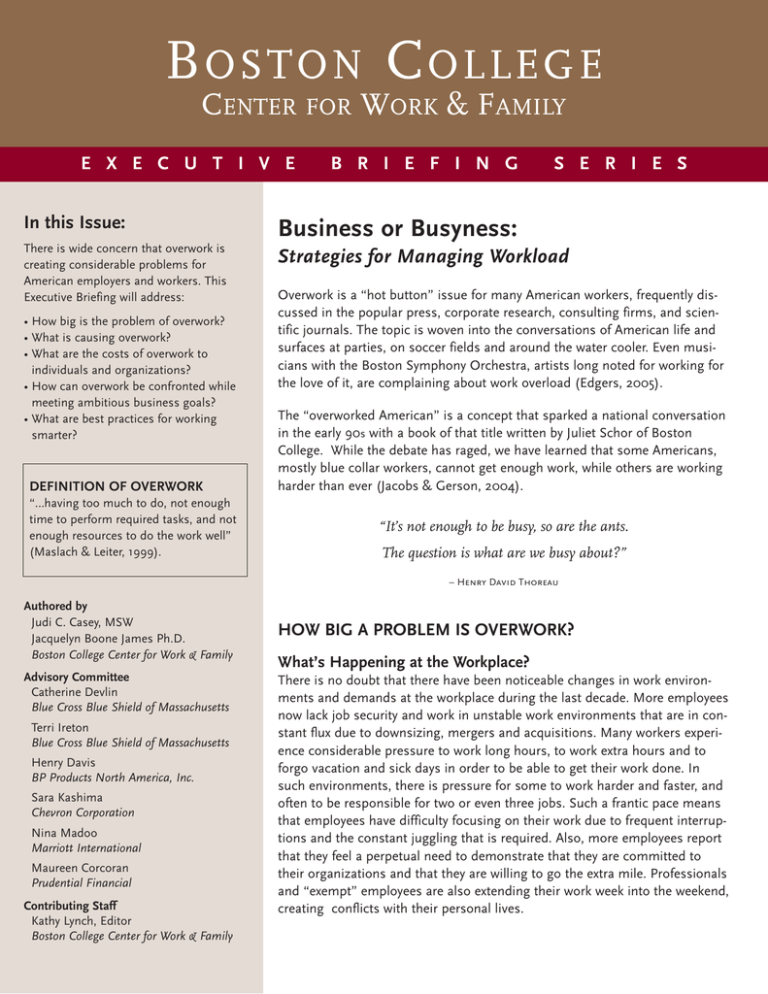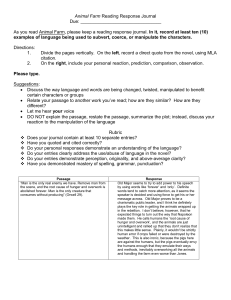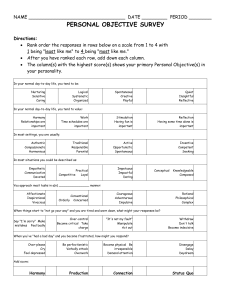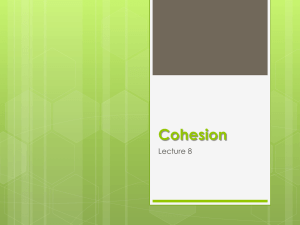B C OSTON OLLEGE
advertisement

B OSTON C OLLEGE CENTER FOR WORK & FAMILY E X E C U T I V E B R I E F I N G S E R I E S In this Issue: Business or Busyness: There is wide concern that overwork is creating considerable problems for American employers and workers. This Executive Briefing will address: Strategies for Managing Workload • How big is the problem of overwork? • What is causing overwork? • What are the costs of overwork to individuals and organizations? • How can overwork be confronted while meeting ambitious business goals? • What are best practices for working smarter? DEFINITION OF OVERWORK “…having too much to do, not enough time to perform required tasks, and not enough resources to do the work well” (Maslach & Leiter, 1999). Overwork is a “hot button” issue for many American workers, frequently discussed in the popular press, corporate research, consulting firms, and scientific journals. The topic is woven into the conversations of American life and surfaces at parties, on soccer fields and around the water cooler. Even musicians with the Boston Symphony Orchestra, artists long noted for working for the love of it, are complaining about work overload (Edgers, 2005). The “overworked American” is a concept that sparked a national conversation in the early 90s with a book of that title written by Juliet Schor of Boston College. While the debate has raged, we have learned that some Americans, mostly blue collar workers, cannot get enough work, while others are working harder than ever (Jacobs & Gerson, 2004). “It’s not enough to be busy, so are the ants. The question is what are we busy about?” – Henry David Thoreau Authored by Judi C. Casey, MSW Jacquelyn Boone James Ph.D. Boston College Center for Work & Family Advisory Committee Catherine Devlin Blue Cross Blue Shield of Massachusetts Terri Ireton Blue Cross Blue Shield of Massachusetts Henry Davis BP Products North America, Inc. Sara Kashima Chevron Corporation Nina Madoo Marriott International Maureen Corcoran Prudential Financial Contributing Staff Kathy Lynch, Editor Boston College Center for Work & Family HOW BIG A PROBLEM IS OVERWORK? What’s Happening at the Workplace? There is no doubt that there have been noticeable changes in work environments and demands at the workplace during the last decade. More employees now lack job security and work in unstable work environments that are in constant flux due to downsizing, mergers and acquisitions. Many workers experience considerable pressure to work long hours, to work extra hours and to forgo vacation and sick days in order to be able to get their work done. In such environments, there is pressure for some to work harder and faster, and often to be responsible for two or even three jobs. Such a frantic pace means that employees have difficulty focusing on their work due to frequent interruptions and the constant juggling that is required. Also, more employees report that they feel a perpetual need to demonstrate that they are committed to their organizations and that they are willing to go the extra mile. Professionals and “exempt” employees are also extending their work week into the weekend, creating conflicts with their personal lives. What’s Happening to Employees? This rigidity in the structure of work and the increase in job demands, especially at the upper levels, present dilemmas for many workers. The “standard workweek” is defined as 35 to 40 hours 5 days a week Monday through Friday. Only 29% of Americans fit this definition. Some report even higher numbers. (Waters Boots, 2004; Presser, 2003) 67% of employed parents say they do not have enough time with • Nearly 70% of families are comprised of either 2 working parents or a single working parent, resulting in more dual earner couples and single parent families at the workplace (Waters Boots, 2004). • Over the past 25 years, the combined weekly work hours of all couples has increased from 70 to 82 hours (Bond, Thompson, Galinksy, & Prottas, 2002). • For dual earner couples with children under age 18, hours have increased from 81 to 91 hours since 1980 (Bond et al., 2002). “Increasingly, women and men alike face challenging work without the traditional, unpaid spouses once taken for granted by husbands in upwardly mobile careers and highly demanding jobs” (Jacobs & Gerson, 2004). Therefore, there are fewer people available to take care of family tasks such as laundry, grocery shopping or child rearing and elder care. Employers’ responses to these changed circumstances vary from expecting employees to do whatever it takes to meet business goals to elaborate job redesign and flexibility programs. their children, 63% of married employees say they do not have enough time with their spouse and more than 50% say they do not have enough time for themselves. (Waters Boots, 2004) FAMILIES AND WORK INSTITUTE 2005 REPORT OVERWORK IN AMERICA: When the Way We Work Becomes Too Much • 44% of US employees are overworked often or very often according to at least one of the definitions described below: - 26% of employees were overworked often or very often in the last month - 27% were overwhelmed by how much work they had to do often or very often in the last month - 29% often or very often didn’t have time to step back and process or reflect on the work they were doing during the last month • 36% of employees do not plan to use their full vacations • 43% return from vacations feeling overwhelmed by what they have to do • 44% of those who are in contact with work outside of normal work hours are highly overworked versus 26% who have little or no contact (Galinsky, Bond, Kim, Backon, Brownfield, & Sakai, 2005) -2- Low Value Work What is it? • Work that does not add value or accomplish business goals. What contributes to it? • A culture of face time, where presence is rewarded, as opposed to performance outcomes such as productivity and work quality. • Managers who are transaction focused, instead of strategic and big-picture oriented. They expect employees to constantly report what they are doing, so that employees spend as much time telling others what they are doing as they spend doing the work. How much is there? • 20% of employee time is spent on low value work (WFD Consulting, 2005). • 29% of employees report that they do a lot of work that is not necessary (Galinsky et al., 2005). Marriott International found that a facilitated, well defined work redesign process was important to gain commitment and sustainability in their organization. By streamlining low value work and focusing on results, managers reported less stress, greater work commitment and a more supportive work environment. IBM's People Oriented Work Redesign Tool -- or "POWR" -- has enabled teams to pinpoint and resolve unnecessary, low value work at the department level and improve productivity among team members. The groups that have used POWR report increased clarity, teamwork and improved processes, which result in the reduction of time and effort spent on activities that do not provide creative and innovative client solutions. How much do we work? In 2000, nearly 1 out of every 8 couples with children was putting in 100 hours a week on the job, compared to only 1 out of 12 families in 1970. (Waters Boots, 2004) Given these huge shifts at the workplace and at home, it is no wonder that many Americans report that they are very busy and under constant pressure to keep up a frenzied pace. In fact, US employees work more weeks of the year than employees in any industrialized country. Compared to European countries, US workers take 14 vacation days while their European counterparts average approximately 33 (Engle, 2003, cited in Murphy & Zagorski, 2005). And there seems to be an increase in the intensity of work involvement with many employees reporting that even when they are not working, they are thinking about work, talking about work or planning what they will do when they return to work. Lastly, many workers are concerned that if they don’t work constantly, they will be ignored for promotions and seen as less committed to the organization than their harder working counterparts. Many employees feel overworked and stressed and the negative consequences for their employers cannot be overstated. One of the key priorities for this year and beyond at PricewaterhouseCoopers is to redesign their work model in order to improve the work/life quality of their people. The Client Portfolio Team pilot project in the Assurance Practice is creating a new team structure where partners and staff have portfolios of clients to help manage workload and deployment. In addition, firm wide simplification efforts are designed to decrease the administrative burden on partners and staff. -3- What Contributes to Overwork? • Low value work • Culture of face time • Advances in technology – laptops, cell phones, Palm Pilots and Blackberries – which erode firm boundaries between work and personal life • Lack of control over workload or pace of work • Poor fit between expectations at work and at home • Global 24/7 economy where teams work across time zones with colleagues from around the world • Increasing work pressures, frequent interruptions, frantic pace, and the need to multi-task • Job insecurity exacerbated by mergers, downsizing and acquisitions • Responsibility for 2 or 3 jobs due to lack of replacements for employees who leave • Lack of respect, trust and autonomy among co-workers and managers • Evening and weekend work required to get the work done • Sleep deprivation • Staff reductions that leave employees without any administrative support • Ineffective use of email (i.e., copying everyone, replying to all when only one person needs a response, sending multiple emails instead of making one phone call) WHAT IS THE COST OF WORK OVERLOAD FOR EMPLOYERS? “Three-quarters of men and women at every life stage are working more hours than they would prefer to work.” (Hertz, 2005) Many studies report correlations between workplace stress, employee burnout, increased healthcare costs, lower productivity, dissatisfaction with work, and more work-family conflict, especially for mothers (Halpern, in press). Such effects have a negative impact on the work environment. • Twenty percent of employees who experience high levels of overwork say they make a lot of mistakes, over one-third feel angry toward their employer and resentful of their coworkers (Galinsky et al., 2005). • Stress costs US employers about $300 billion per year in absenteeism, employee turnover, productivity and direct medical costs (American Institute of Stress, 2005). • Burnout is responsible for job dissatisfaction, low organizational commitment, absenteeism, desire to leave and turnover (Schaufeli & Enzmann, 1998). • Employees are less likely to want to advance. In a study of global leaders, 67% of executives have reduced their career aspirations due to the anticipated sacrifices that would be required in their personal lives (Galinsky, Salamond, Bond, Brumit-Kropf, & Harrington, 2003). • The worst news for employers is that they may be burning out their best performers (Messmer, 2004). Since top performers are often given the toughest assignments with the biggest challenges, they are the most likely to struggle with overwork, but the least likely to ask for help or set limits. -4- WHAT DO WE KNOW FROM RESEARCH ABOUT WORKLOAD ISSUES AND OVERWORK? Both the popular press and work/life consulting firms are reporting that “we work too hard,” and that both the number of hours worked and the pace of work has increased dramatically in the last decade. Generally these results are supported by scientific studies, although the picture of overwork is more complex than indicated by first glance. “The hot button” resilience issue is managing workload – less than 10% of organizations say that they are doing well at managing workload and close to 50% surveyed rate their organizations low. (WFD Consulting, 2004) First of all, long hours are not always a problem for workers. • Hourly and low wage workers cannot get the hours they need to work; they want more (Jacobs & Gerson, 2004). • At the other end of the spectrum, remember the “happy workaholic,” who works long and hard, feels that this is a personal choice, and does not resent it (Friedman & Lobel, 2003). • Psychologists have long documented that Americans have a strong emotional attachment to work. Indeed, people are more likely to report optimal levels of experience, such as enjoying themselves or feeling their best at work, than during leisure hours (Csikszentmihalyi, 1990). In studies of dual earner couples, the number of hours worked is not always correlated with burnout. If employees work either more or fewer hours than they want to work and if their schedules are different from their partner’s schedule, they become disengaged, distracted and alienated at work. This leads to decreased job satisfaction and increased turnover (Barnett, Gareis, & Brennan, 1999). Having some autonomy and control in terms of how work is organized ameliorates the negative outcomes of overwork. For example, a group of nurses who had more control over how their work was organized were compared to another group who worked their traditional schedules. The nurses with traditional schedules had higher health care usage than the nurses with more control over their schedules, regardless of workload (Ganster, Dwyer, & Fox, 2001). At Best Buy’s corporate campus, overwork syndrome is gradually being eradicated by giving workers some control. Their new Results-Oriented Work Environment lets employees adopt a fluid way of working, free from the focus on time. It is the new flexibility game, one where the unwritten rules are being rewritten so that judgment about anything but results is not tolerated. Employees at all levels are systematically challenging their own deeply held assumptions about how work works. Workload and the tension around it seem to be mediated by the extent to which employees have faith in management. In a study of accountants, work overload was related to burnout, psychological strain, and work’s interference with family. “Trust in management” was found to moderate these effects. Employees who have a high degree of trust in management may experience reduced strain because they do not fear punitive repercussions for failure to complete their assigned work (Harvey, Kelloway, & Duncan-Leiper, 2003). -5- “… burnout is not a problem of people but mostly of the places in which they work. When the workplace does not recognize the human side of work or demands superhuman efforts, people feel overloaded, frustrated and well, burned out. Self-improvement alone will not beat it.” (Maslach & Leiter, 1999) Alcan Inc.'s Work Life Effectiveness Strategy is part of EHS FIRST, the company’s global Environment, Health and Safety Management system. Workload issues and the subsequent culture of long hours are the main issues being addressed by the strategy, through increased focus on working hard but smarter; identifying and eliminating unnecessary or low value work; and utilizing 6 Sigma Continuous Improvement techniques to drive process improvement. Effective workload management, process improvement and culture change do not happen overnight, so senior executives are receiving executive coaching to improve their leadership skills while employees receive Resilience Coaching. Findings from the AstraZeneca Pharmaceuticals Work Environment Flexibility and Effectiveness study show that having flexibility is strongly related to resilience and the ability to handle workload. Employees who have the flexibility they need are more likely to "strongly agree" or "agree" on defined resilience indicators concerning managing pressure and pace. Also, they are more likely to agree that they have control over their work and have a manageable workload. GlaxoSmithKline has a program on their intranet that consists of a web-based survey tool, as well as a slide presentation for managers to facilitate a meeting to discuss survey results, and develop action plans to change how work is done. The goal is to enhance both work/life balance and work performance. They use the web as the delivery channel to ensure that all managers and their teams have access to the process anywhere they work globally. They believe that teams working together can best determine how to make work changes that are successful for both themselves and the business. WHAT IS CONTROL? Here are questions used to determine the extent to which employees have autonomy or control over how their work is organized (Van Veldhoven & Meijman, 1994): Can you choose the methods to use in carrying out your work? Do you plan your own work? Do you set your own pace? Can you vary how you do your work? On your job, do you have the freedom to take a break whenever you want to? Do you decide the order in which you do things? Do you decide when to finish a piece of work? Do you have full authority as to how much time you spend on a particular piece of work? Can you decide how to go about getting your job done? Does your job allow you to organize your work by yourself? Do you have the full authority to determine the content of your work? -6- WORKING SMARTER What can be done to reduce overwork while meeting business goals? Individuals • Regularly analyze the tasks that you perform and distinguish between the vital and the disposable • Make adjustments that will ease work pressure without significant sacrifice of quality • Take vacations; take sick time if needed • Assess the best fit between your work and personal life • Set firm boundaries between work and non-work time • Take care of your health – exercise, eat healthy, sleep • Minimize interruptions and distractions • Expect recognition and rewards from co-workers and managers • Insist that you are treated with respect and fairness Managers • Rethink workflow and division of labor. Is there a better way to achieve results without overtaxing your resources? • Consider cross-training as both a developmental and coverage strategy • Provide learning and retraining opportunities • Give employees some choice over their work and control over their schedule • Assess the fit between job requirements and employee needs • Ask employees for input about management decisions • Support and encourage vacations • Focus on performance outcomes, not face time • Thank people and recognize them publicly • Ask employees about their workload Teams • Determine expectations about how accessible members need to be (evenings, weekends, holidays) • Reduce low value work • Set realistic work plans • Develop boundaries around interruptions • Create solutions that meet employee, team and business needs • Establish flexible ways to get work done with a focus on outcomes Organizations • Reward leaders that effectively manage human resources and their own time toward the achievement of goals • Disincent unproductive management behavior that encourages overwork • Embrace a performance-based culture • Create a culture of flexibility • Articulate clear organizational values • Establish effective ways to resolve conflict (From Katcher, 2003, as cited in Bates, 2003; Galinsky et al., 2005; Maslach & Murphy, 2005, as cited in Halpern & Murphy, 2005) -7- A Publication of the Boston College Center for Work & Family “Excessive working hours continue to be a serious problem facing individuals, their families, communities and businesses. Despite widespread recognition of the problem of overwork for more than a decade, the trend in hours worked continues upward. Large majorities of employees are articulating concern that their hours are too long. Coupled with the ongoing increase in workloads faced by many employees, stress and overload are a persistent challenge faced by companies.” — Juliet Schor In sum, certain workers cannot get enough work, while some are working too hard. In one sense, overwork has to do with perception and choice; one worker’s optimal schedule is another’s nightmare. Personal preference for working long hours is an important factor in whether long hours are perceived as overwork. Employees with high control and high workload managed their workload with none of the negative consequences typically associated with overwork. A responsive and respectful manager can make a heavy workload seem less onerous. Contrary to popular opinion, longer work hours are not an indication of higher employee commitment to the company and the job. Work overload can be a barrier to achieving work/life effectiveness, even where policies and programs to support employees are in place. Fortunately, there are some strategies for alleviating the strain. “Americans talk a great deal about time-crunch. We ask each other, About this Series Written for an executive level audience, the Boston College Center for Work & Family Executive Briefing Series addresses topical and strategic issues of particular relevance to the current business climate. The series highlights research findings, data trends and best practices in a concise format, aiming to foster action-oriented dialogue within organizations. Each issue features an accompanying PowerPoint presentation that captures key points and includes a section for practitioners to customize and add organization-specific data. About the Center Since its founding in 1990, the Boston College Center for Work & Family has been a national leader in helping organizations create effective workplaces that support and develop healthy and productive employees. The Center provides a bridge linking the academic community to the applied world of the work/life practitioner and has three main focus areas: research, membership, and education. The Center is committed to enhancing the quality of life of today's workforce by providing leadership for the integration of work and life, an essential for business and community success. “How are you?” And we answer: “Busy.” … I wonder if other cultures suffer from our timing disorder, our “irrational exuberance.” Busyness, we believe, is part of our creed.” (Goodman, 2005) -8- The Boston College Center for Work & Family 22 Stone Avenue Chestnut Hill, MA 02467 Ph: (617) 552-2844 Fax: (617) 552-2859 http://www.bc.edu/cwf







